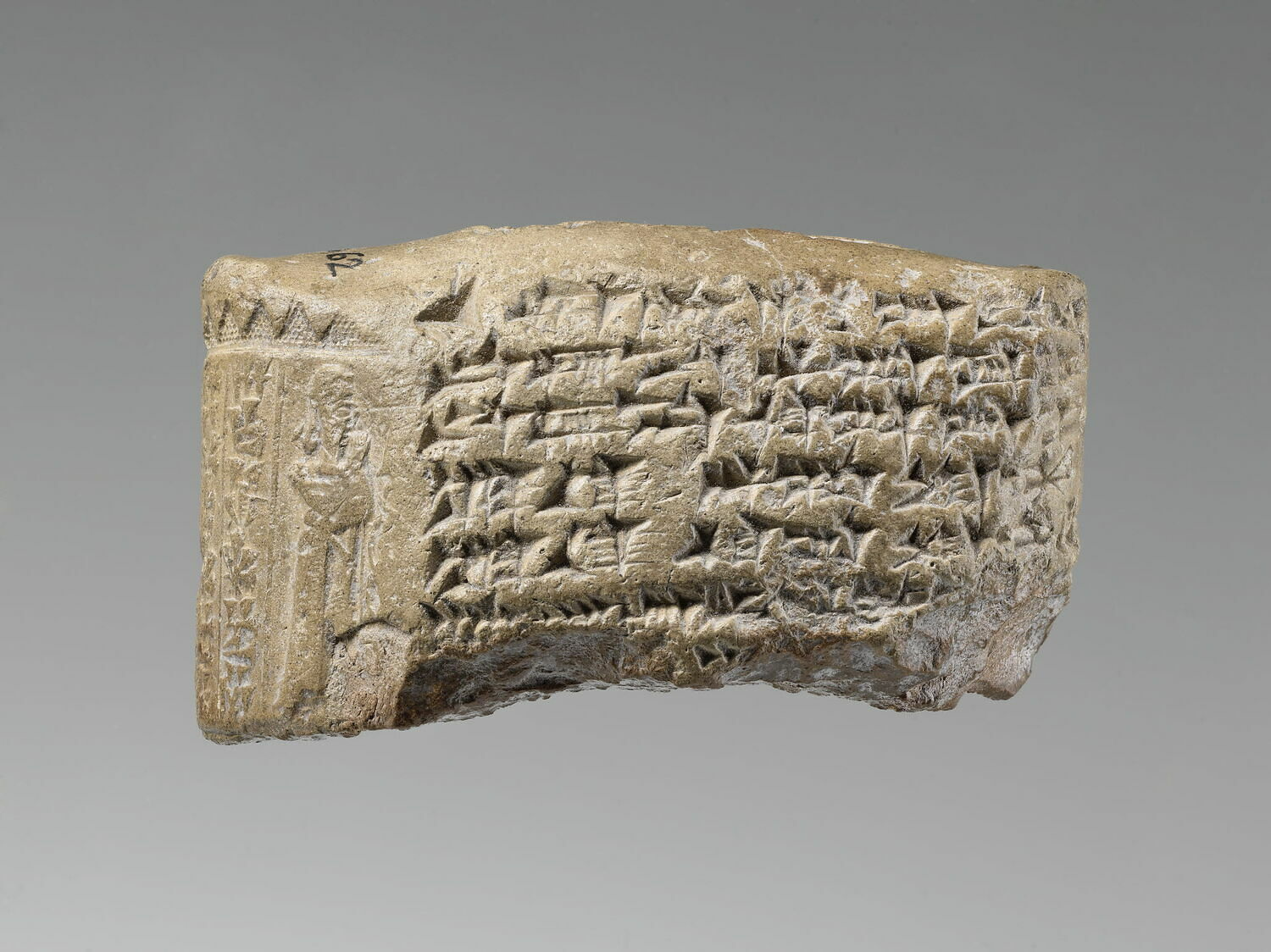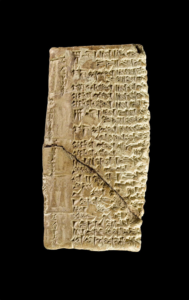Ancient Lives Preserved in Cuneiform
Impressions of Mesopotamian Society Over 3,500 Years Ago
Amanda Podany
History Professor Emeritus, CalPoly Pomona
Author of Weavers, Scribes, and Kings: A New History of the Ancient Near East
Sponsored by PSW Science Members Brad Calvin & Robin Taylor and Larry Millstein
About the Lecture

Perhaps the oldest urban civilization on Earth is also, remarkably, the ancient culture for which we have the most documentation. For about 3,000 years, starting in 3200 BCE, the scribes of ancient Mesopotamia (modern Iraq), and of its immediate neighbors in what are now Syria, Turkey, and Iran, produced millions of texts. At least 500,000 of these have been found and they represent an extraordinary resource for historians today. These documents reveal details about daily life, legal practices, and professions that can rarely even be glimpsed in other ancient cultures.
The reason for the texts’ survival is that the writing medium in and around Mesopotamia was usually clay, formed into tablets that were dried in the sun or baked after they had been inscribed. Texts are found almost everywhere that excavations take place in these parts of the Middle East – in ancient temples and palaces, private houses, and even streets. In contrast, scribes in neighboring cultures, such as Egypt, Canaan, Israel, Greece, and Rome, generally wrote on organic materials, such as papyrus and leather, and the vast majority of their documents have long since decomposed.
The cuneiform script inscribed on the clay tablets was both phonetic (with some signs used to represent syllables) and logographic (with other signs used to represent whole words), and it was adapted to record many spoken languages. A few texts, such as royal inscriptions, were written with an eye to the future, but the vast majority comprise practical documents such as administrative records, school exercises, letters, contracts, lists, court cases, and so on.
This talk will demonstrate some of the rich and varied ways that cuneiform tablets have been used to reconstruct the world in which they were written, and the possibilities they present for future study. The texts provide historians with data about individuals–male and female, rich and poor, young and old, many of whom were far from the halls of power. Their lives and experiences can be examined through the lens of microhistory, as windows into their eras. Cuneiform documents also reflect the legal system, one of the world’s earliest, and its remarkable attention to fairness for all. And the clay tablets can be examined as physical artifacts that changed over time and provide evidence for the chronology of events thousands of years ago.
As a case study, the history of the ancient kingdom of Hana, in the Middle Euphrates region of Syria, will be examined through all these approaches. Its chronology, beginning in the 18th century BCE, has been elucidated through a study of these documents, its legal practices (reflected in contracts) prove to have been remarkable, and the people who lived there come alive through a study of the families and the neighborhoods in which they lived.
Selected Reading & Media References
Amanda H. Podany, Weavers, Scribes, and Kings: A New History of the Ancient Near East. Oxford University Press, New York and London, 2022.
Amanda H. Podany, The Land of Hana: Kings, Chronology, and Scribal Tradition. CDL Press, Bethesda, Maryland, 2002.
Amanda H. Podany: “What the Tablets Say.” Aeon, February 9, 2023, https://aeon.co/essays/in-the-3700-year-footsteps-of-a-king-a-barber-and-a-slave
New Books Network podcast: Weavers, Scribes, and Kings, https://newbooksnetwork.com/weavers-scribes-and-kings

About the Speaker

Amanda H. Podany is Professor Emeritus of History at Cal Poly Pomona, where she has been on the faculty since 1990.
Amanda’s research focuses on Syria in the second millennium BCE, with attention to chronology, scribal practice, international relations, and kingship. She has helped pioneer the use of microhistory to study cuneiform archives, exploring and contextualizing the lives of ancient individuals. Much of Amanda’s scholarly work has centered on the land of Hana, located in the Middle Euphrates region of Syria.
Amanda is an author on numerous scholarly articles. She has authored four books and is co-author of another. And she is the author and presenter of a 24-part series of lectures on ancient Mesopotamia for Wondrium/Great Courses. She has a particular interest in making recent findings in her field accessible to a wider audience and has presented numerous public lectures at museums and universities (among other institutions) including the Getty Museum and the Morgan Library.
In her first book, The Land of Hana: Kings, Chronology, and Scribal Tradition (2002), she made the case for a revision of the conventional dating of the Hana kingdom, proving that the kingdom flourished after the 16th century BCE, rather than before. Her revised chronology has been adopted by other scholars and has contributed to other studies of chronological debates concerning the second millennium BCE. Her most recent book, Weavers, Scribes, and Kings: A New History of the Ancient Near East (2022) recounts more than 3,000 years of history through the eyes of people of all walks of life, using a microhistorical approach.
Amanda has been the recipient of numerous awards including a research award from the NEH, and, among many invited lectures, she was chosen to give the Abraham Sachs annual lecture in Assyriology at Brown University. She received the Norris and Carol Hundley Award from the American Historical Association for her book, Brotherhood of Kings, and her book Weavers Scribes, and Kings was recently selected as a finalist for a PROSE award, in the field of Biological Anthropology, Archaeology and Ancient History, from the Association of American Publishers. Amanda also serves on several boards, including the Advisory Committees for Open Richly Annotated Cuneiform Corpus, the California History-Social Science Project, and the Society for History Education.
Amanda earned a BA in Anthropology at UCLA, an MA in Archaeology of Western Asia at the Institute of Archaeology, University of London, and a PhD in History of the Ancient Near East at UCLA.
Minutes
On April 28th, 2023, from the Powell Auditorium of the Cosmos Club in Washington, D.C, and by Zoom webinar broadcast on the PSW Science YouTube channel, President Larry Millstein called the 2,476th meeting of the Society to order at 8:03 p.m. Eastern Time. He welcomed new members, and the recording secretary read the minutes of the previous meeting.
President Millstein then introduced the speaker for the evening, Amanda Podany, History Professor Emeritus at the CalPoly Pomona. Her lecture was titled, “Ancient Lives Preserved in Cuneiform.”
Podany focused on Mesopotamian people who lived over 3500 years ago. Despite the significant time gap, tablets inscribed in cuneiform script provide abundant information about both communities and individuals, including non-powerful figures.
Podany highlighted the wealth of knowledge obtained from surviving Mesopotamian documents, particularly clay tablets covered in cuneiform script. The speaker acknowledged the challenge of unevenly spread information throughout Mesopotamian history. The tablets offer insights into various aspects of ancient life, and while millions more remain undiscovered, the speaker focused on analyzing a specific tablet within the broader historical context.
Podany went on to discuss the discovery and analysis of several cuneiform tablets that provide evidence about the ancient city of Terqa and the kingdom of Hana.
The tablets share common features and suggest a connection, she explained, between the rulers of Hana and King Hammurabi of Babylon. The analysis of these tablets provides insights into the historical timeline and the development of writing during the Old Babylonian period.
She then related her own experience working on an archaeological excavation at the site of Terqa in Syria in 1983. She mentioned that Terqa was possibly the capital of the ancient Kingdom of Hana, which extended north along the Khabur River. The excavation team faced challenges due to the modern town of Ashara built on top of the ancient city, limiting their excavation areas. The speaker's main interest was in the social significance of the cuneiform tablets found at the site.
The speaker then discussed her research on the tablets recovered from the ancient kingdom of Hana. The focus of her analysis was to determine the sequence in which the tablets were written, especially those with Royal seals. Her research primarily revolved around figuring out the chronology of the Kings of Hana. She analyzed various characteristics of the tablets, including personal names and determinatives, and observed differences between earlier and later writings.
Podany further pondered the distribution of cuneiform archives and libraries over time, with certain periods and places being more represented than others. She emphasized the evolving understanding of Hana's history based on the analysis of the tablets and the importance of archaeological discoveries in shaping historical knowledge.
One site, Rushdogan, stood out with over 10,000 tablets found within a 68-year period. The speaker emphasized the disproportionate distribution of tablets, highlighting the opportunity to study micro histories. She then mentioned her own book, " Weavers, Scribes, and Kings: A New History of the Ancient Near East," which explores the lives of individuals from various professions and time periods, including a micro history of a man named Pagiram.
Next the question and answer period began.
A lifetime member of PSW asked what grew in the fields, and who conquered Babylon in the dark ages. The speaker responded that the fields were largely used to grow barley. Additionally, some fields grew wheat, onions, leeks, garlic, and generally green vegetables and sweets such as dates. She continued to explain that many peoples are blamed for the conquering of Babylon, and discussed some of the primary considerations.
An online viewer asked whether the letters from the 1300s BC in Egypt could tell us anything about Hana. The speaker said that unfortunately, the treasure trove of letters between the kings is not valuable for learning about the kingdom of Hana, which is not referred to by any of the literature at the time.
After the question and answer period, President Millstein thanked the speaker, made the usual housekeeping announcements, and invited guests to join the Society. President Millstein adjourned the meeting at 10:02 p.m. Eastern Time.
Temperature in Washington, D.C.: 16° C
Weather: Cloudy
Attendance: Powell Auditorium 60; YouTube Live Stream 37, for a total in-person attendance of 97. Views in the 2 weeks after the lecture: 698.
Respectfully submitted,
Conor Nixon on behalf of the Recording Secretary, Cameo Lance